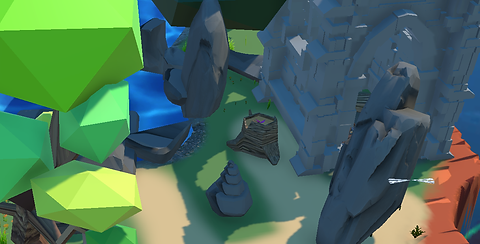A Guide to Kiki Watching VR
A VR game where players photograph butterflies in a magical forest.
Fill out a guide book to summon the Butterfly Queen.

Project Deliverable
3D Modeling
Environment Design
Game Design
Tool
Oculus Quest 2
Figma
Blender
Unity 3D
Timeline
Fall 2024 (Two Weeks)
Team
3D Artist: Ye, Jose
Programmer: Lea, Nellie
Sound Designer: Courtney
Challenge
Our biggest challenge is enabling naive users to complete the entire VR experience without instructions, while maintaining strong immersion. The experience is designed for a limited 4m × 5m space, requiring intuitive interaction and smart spatial design to guide users and evoke a sense of a much larger virtual world.
Opportunity
Our key opportunity lies in integrating the tutorial as a core game mechanic, making learning part of the experience itself. We also aim to let users move freely within a small physical space while easily sensing the contrast and depth of the larger virtual environment.
OVERVIEW
The Experience
The player explores a magical forest, guided by a butterfly notebook, and captures photos of butterflies across diverse terrains. As they experience the spatial richness of the virtual world—moving through open fields, dense woods, and hidden clearings—they gradually fill their guidebook. Once completed, they earn the chance to summon the mystical Butterfly Queen.
OVERVIEW
My Role
I was responsible for creating the full environment in Blender, including modeling and material design for all objects. Additionally, I designed the complete game map to ensure a dynamic and enjoyable experience for players.
DESIGN
Game Design
01. Map design
When we learned that our users were naive VR users and would only have a 4m × 5m space to play in, I initially designed the map to fit within this limited area. I used various objects to help users distinguish between different zones of the environment. However, during interim playtesting, we found that users did not move around the space to explore the world as intended.

After the interim stage, I realized there were two main reasons users didn’t move around to explore the map. First, the boundaries of the environment were too obvious, making the limited space feel constrained. Second, the open visibility offered no visual obstacles, so users felt no need to move around. To address this in the final version, I increased the map size by four times, blurred the edges of the environment, and added various visual blockages to encourage physical exploration within the space.

02. Design for naive users
In order to allow naive users to navigate the world without relying on tutorials, we integrated the map and the butterfly notebook to guide exploration through visual cues and intuitive observation.


DESIGN
Environment Design
The environmental design aimed to ensure that each area had identifiable characteristics that users could uncover, guiding and supporting the game's progression. We also hope to use visual designs that make users feel part of a bigger world.

Stone Alter

Tree stump

Stone Church

Camp Fire
We also hope to use visual designs that make users feel part of a bigger world. As the space becomes larger and more elements are added to the scene, the modeling precision decreases in order to ensure smooth rendering in VR without stuttering.

Before

After
DELIVERABLE
Final Design